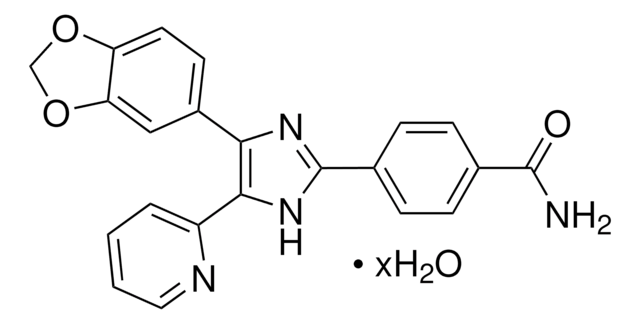S8822
SB-525334
≥98% (HPLC), solid, ALK5 inhibitor
Sinônimo(s):
6-[2-tert-Butyl-5-(6-methyl-pyridin-2-yl)-1H-imidazol-4-yl]-quinoxaline
About This Item
product name
SB-525334, ≥98% (HPLC)
Ensaio
≥98% (HPLC)
forma
solid
cor
yellow
solubilidade
DMSO: ≥20 mg/mL
originador
GlaxoSmithKline
temperatura de armazenamento
2-8°C
cadeia de caracteres SMILES
Cc1cccc(n1)-c2[nH]c(nc2-c3ccc4nccnc4c3)C(C)(C)C
InChI
1S/C21H21N5/c1-13-6-5-7-16(24-13)19-18(25-20(26-19)21(2,3)4)14-8-9-15-17(12-14)23-11-10-22-15/h5-12H,1-4H3,(H,25,26)
chave InChI
DKPQHFZUICCZHF-UHFFFAOYSA-N
Aplicação
Ações bioquímicas/fisiológicas
Características e benefícios
Código de classe de armazenamento
11 - Combustible Solids
Classe de risco de água (WGK)
WGK 3
Equipamento de proteção individual
dust mask type N95 (US), Eyeshields, Faceshields, Gloves
Certificados de análise (COA)
Busque Certificados de análise (COA) digitando o Número do Lote do produto. Os números de lote e remessa podem ser encontrados no rótulo de um produto após a palavra “Lot” ou “Batch”.
Já possui este produto?
Encontre a documentação dos produtos que você adquiriu recentemente na biblioteca de documentos.
Os clientes também visualizaram
Nossa equipe de cientistas tem experiência em todas as áreas de pesquisa, incluindo Life Sciences, ciência de materiais, síntese química, cromatografia, química analítica e muitas outras.
Entre em contato com a assistência técnica





